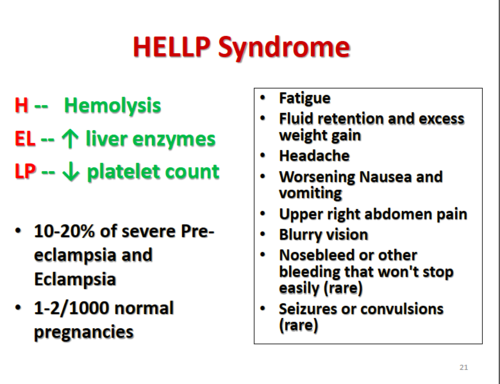A nurse is providing discharge teaching to a client who had preeclampsia and delivered a healthy baby at 38 weeks of gestation.
Which of the following instructions should the nurse include in the teaching?
Report any headache that is not relieved by acetaminophen
Expect some vaginal bleeding for up to 6 weeks postpartum
Resume sexual activity as soon as you feel comfortable
Drink at least 3 liters of fluid per day to prevent dehydration
The Correct Answer is A
Report any headache that is not relieved by acetaminophen. This is because a headache that persists despite taking pain medication can be a sign of increased blood pressure or brain swelling, which are serious complications of preeclampsia.
Choice B is wrong because some vaginal bleeding for up to 6 weeks postpartum is normal and expected for any woman who has given birth, regardless of whether she had preeclampsia or not.
Choice C is wrong because resuming sexual activity as soon as you feel comfortable is also a normal recommendation for any woman who has given birth, unless there are other medical reasons to avoid it.
Choice D is wrong because drinking at least 3 liters of fluid per day to prevent dehydration is not necessary for a woman who had preeclampsia. In fact, drinking too much fluid can worsen the swelling and fluid retention that are common in preeclampsia.
Nursing Test Bank
Naxlex Comprehensive Predictor Exams
Related Questions
Correct Answer is A
Explanation
This is because HELLP syndrome is a complication of pregnancy that affects the liver and blood clotting.It can cause liver damage, bleeding problems, and high blood pressure.Epigastric pain or right upper quadrant pain is a sign of liver injury or rupture.

Choice B is wrong because blurred vision or flashes of light are symptoms of preeclampsia, not HELLP syndrome.
Preeclampsia is a condition that causes high blood pressure and protein in the urine during pregnancy.It can lead to HELLP syndrome, but not all women with preeclampsia develop HELLP syndrome.
Choice C is wrong because decreased urinary output or oliguria are also symptoms of preeclampsia, not HELLP syndrome.
Oliguria means producing less than 400 mL of urine in 24 hours.It can indicate kidney damage or failure due to high blood pressure or proteinuria.
Choice D is wrong because hyperreflexia or clonus are also symptoms of preeclampsia, not HELLP syndrome.
Hyperreflexia means having exaggerated reflexes, while clonus means having involuntary muscle spasms.
They can indicate nervous system involvement or seizures due to high
Correct Answer is A
Explanation
The most likely explanation for the client's findings of severe headache, blurred vision, hyperreflexia, and clonus in the context of severe pre-eclampsia is A. Cerebral edema.
Pre-eclampsia is a pregnancy-related condition characterized by high blood pressure (hypertension) and signs of organ damage, most commonly affecting the liver and kidneys. Severe pre-eclampsia can lead to complications such as eclampsia, which is characterized by seizures. The symptoms described by the client, including severe headache and blurred vision, are consistent with neurological manifestations associated with severe pre-eclampsia.
Hyperreflexia refers to an exaggerated reflex response, and clonus refers to rhythmic contractions of a muscle when it is passively stretched. Both hyperreflexia and clonus are indicative of central nervous system (CNS) hyperexcitability. Cerebral edema, which is the swelling of the brain due to fluid accumulation, can lead to increased intracranial pressure and neurological symptoms such as headache, vision changes, hyperreflexia, and clonus.
While other complications such as pulmonary edema (B), hemolysis (C), and thrombocytopenia (D) can occur in severe pre-eclampsia, they are not directly associated with the reported symptoms of severe headache, blurred vision, hyperreflexia, and clonus.
Pre-eclampsia is a pregnancy-related condition characterized by high blood pressure (hypertension) and signs of organ damage, most commonly affecting the liver and kidneys. Severe pre-eclampsia can lead to complications such as eclampsia, which is characterized by seizures. The symptoms described by the client, including severe headache and blurred vision, are consistent with neurological manifestations associated with severe pre-eclampsia.
Hyperreflexia refers to an exaggerated reflex response, and clonus refers to rhythmic contractions of a muscle when it is passively stretched. Both hyperreflexia and clonus are indicative of central nervous system (CNS) hyperexcitability. Cerebral edema, which is the swelling of the brain due to fluid accumulation, can lead to increased intracranial pressure and neurological symptoms such as headache, vision changes, hyperreflexia, and clonus.
While other complications such as pulmonary edema (B), hemolysis (C), and thrombocytopenia (D) can occur in severe pre-eclampsia, they are not directly associated with the reported symptoms of severe headache, blurred vision, hyperreflexia, and clonus.
Whether you are a student looking to ace your exams or a practicing nurse seeking to enhance your expertise , our nursing education contents will empower you with the confidence and competence to make a difference in the lives of patients and become a respected leader in the healthcare field.
Visit Naxlex, invest in your future and unlock endless possibilities with our unparalleled nursing education contents today
Report Wrong Answer on the Current Question
Do you disagree with the answer? If yes, what is your expected answer? Explain.
Kindly be descriptive with the issue you are facing.
